Remember getting amazed by its swift response during your first encounter with this plant? Ever wondered what is the mechanism behind this intriguing behaviour?
Although it is commonly sighted in Singapore, do you know that it originated somewhere far away?
Do you know in which country is the plant used for assisting childbirth?
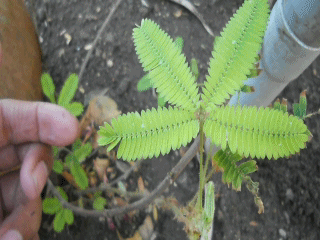 |
| Figure 1: Behaviour of the M. pudica (Hrushikesh, 2011) |
Read on to learn more about the M. pudica.
This seemingly small, timid and inconspicuous plant may just surprise you.
INTRODUCTION
Table of Contents
Origin of name
The etymology of the plant is as follows - “Mimosa” is understood as mimic in Greek while “pudica” is understood as shy in Latin. Together, the name implies the folding behaviour exhibited by the leaves of the plant upon exposure to external physical disturbance or contact [1].
Other associated names
The family name and common names of the plant are listed below [1]:
Family Name : Fabaceae (Leguminosae)
Common Names : Sensitive Plant, Touch-me-not, Shame Plant, Live-and-die, Humble Plant, Action Plant, Rumput Simalu, Mimosa, Malu-malu
Chinese Name : 含羞草
Distribution
Originated in the tropical Central and South America, this plant has now been naturalised throughout the tropics. However, it has been regarded as an invasive species in countries like Kenya, Tanzania and Uganda [2].
GENERAL BIOLOGY
Description
The M. pudica usually reaches between 50-70 cm in height [3]. The plant has bipinnate leaves, each with roughly 5 elongated primary leaflets. There are between 15-20 pairs of secondary leaflets or pinnules on each primary leaflet. Each pinnule can reach up to 0.5 cm in length [1]. Older leaves exhibit a darker green colour as compared to younger ones [4]. Figure 2 below shows how a bipinnate leaf looks like.
| Figure 2: Structure of a bipinnate leaf (Armstrong, 2002) |
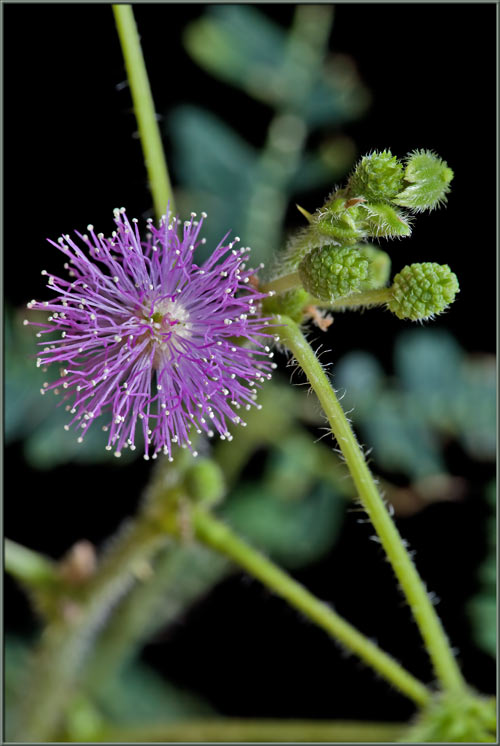 |
| Figure 3: M. pudica inflorescence (Johnston, 2009) |
Blooming in different shades of pink and purple, each flower-head is actually an an inflorescence of small flowers that together resemble a pom-pom. Also known as a capitulum, the inflorescence may reach up to 1.5 cm in diameter [4]. Figure 3 shows the inflorescence of the M. pudica. Next to the flower are the buds of the plant. The buds have a texture similar to that of pineapples as shown in Figure 4 [4].
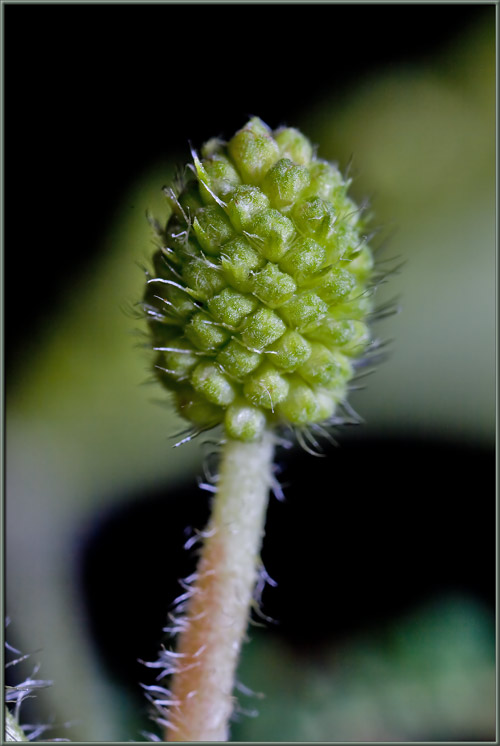 |
| Figure 4: M. pudica bud (Johnston, 2009) |
Reproductive biology
The plant can be pollinated using biotic and abiotic methods. The former includes pollination by insects and mammals while the latter includes pollination via wind or a water medium [1]. After undergoing pollination and fertilisation processes, the plant produces seeds. As many as 675 seeds are produced by each plant annually [5].
Plant movement
(a) Plant movement upon physical disturbances
(Seismonastic movement)The leaf-folding behaviour exhibited upon physical disturbance was initially thought to be associated with the presence of animal-like nerves and tissues within the plant. Subsequent studies about the plant refuted this claim. Robert Hooke (1635-1703), an English scientist, was one of the pioneering scientists who studied the plant [3]. Hooke hypothesised that this behaviour was due to pressure from the disturbance which trigger water flow within the leaves that force them to move in a downward direction [6].
| Figure 5: Pulvini on M. pudica leaflets (Johnston, 2009) |
Currently, it is accepted that the pulvinus (plural: pulvini) plays a major role in this behaviour. Located at the base of the leaf stalk, the pulvinus is formed of motor cells and water- and nutrient-conducting tissues that are responsible for the plant movements [7]. Upon some physical disturbance, an electrical signal is triggered. The translation of the electrical signal into a chemical signal results in the pumping of potassium ions from cells of part of the pulvinus to the intercellular space present in the other part of the same pulvinus. This influences water movement and osmosis causes water to accumulate on one side of the pulvinus. The side where water drains from droops and folds due to the reduction in turgor [8]. A recent found that the folding behaviour occurs in 4-5 seconds but the re-opening process of the leaflets can take up to 600 seconds [9].
Figure 5 on the left shows the pulvini on the leaflets. The pulvini are the small white dots that you see.
The M. pudica is an extremely sensitive plant. Apart from touch, physical disturbances that could lead to such movement include wind, heat and extreme light conditions [8]. Such physical response to disturbances is termed as seismonastic movement [3].
(b) Plant movement at night
(Nyctinastic movement)During the evening, leaflets fold up and the leaves sag. The leaflets remain in this position till the next morning [10]. An experiment by a French scientist in the 18th century involved placing the M. pudica in a cave in total darkness and it was observed that the behaviour continued. The scientist hypothesised that this was possible due to the inherent rhythm or biological clock that the plant has [11]. Such physical behaviour is termed as nyctinastic movement [10].
(c) Evolutionary function of plant movements
Figure 6 below shows the spines on the plant. Upon disturbance, the leaflets close up and spines on the plant appear much more obvious. This may deter herbivores from going near the plant or consuming it [4]. Other than the spines, folded leaves may appear unattractive to herbivores thereby lowering their chances of being consumed. In addition, such behaviours may reduce the likelihood of desiccation because lesser heat and water transfer to the environment take place when the leaves are not completely opened [10].
| Figure 6: Spines on M. pudica (Johnston, 2009) |
Environmental conditions
The plant is generally easy to maintain. It prefers environments with strong sunlight and does not require much water for growth [1]. The plant can be found in various habitats, including agricultural land, forest plantations, pastures and disturbed sites such as roadsides [12].
Similar-looking species
The M. pudica, Mimosa pigra (giant sensitive plant) and Mimosa diplotricha var. diplotricha (creeping sensitive plant) have similar appearances. Pink inflorescences and spines are common features that these species have. Unlike the other two species which have an upright growth pattern, the M. pudica, with a spreading growth pattern, remains flat and lying on the ground throughout its lifetime [2].
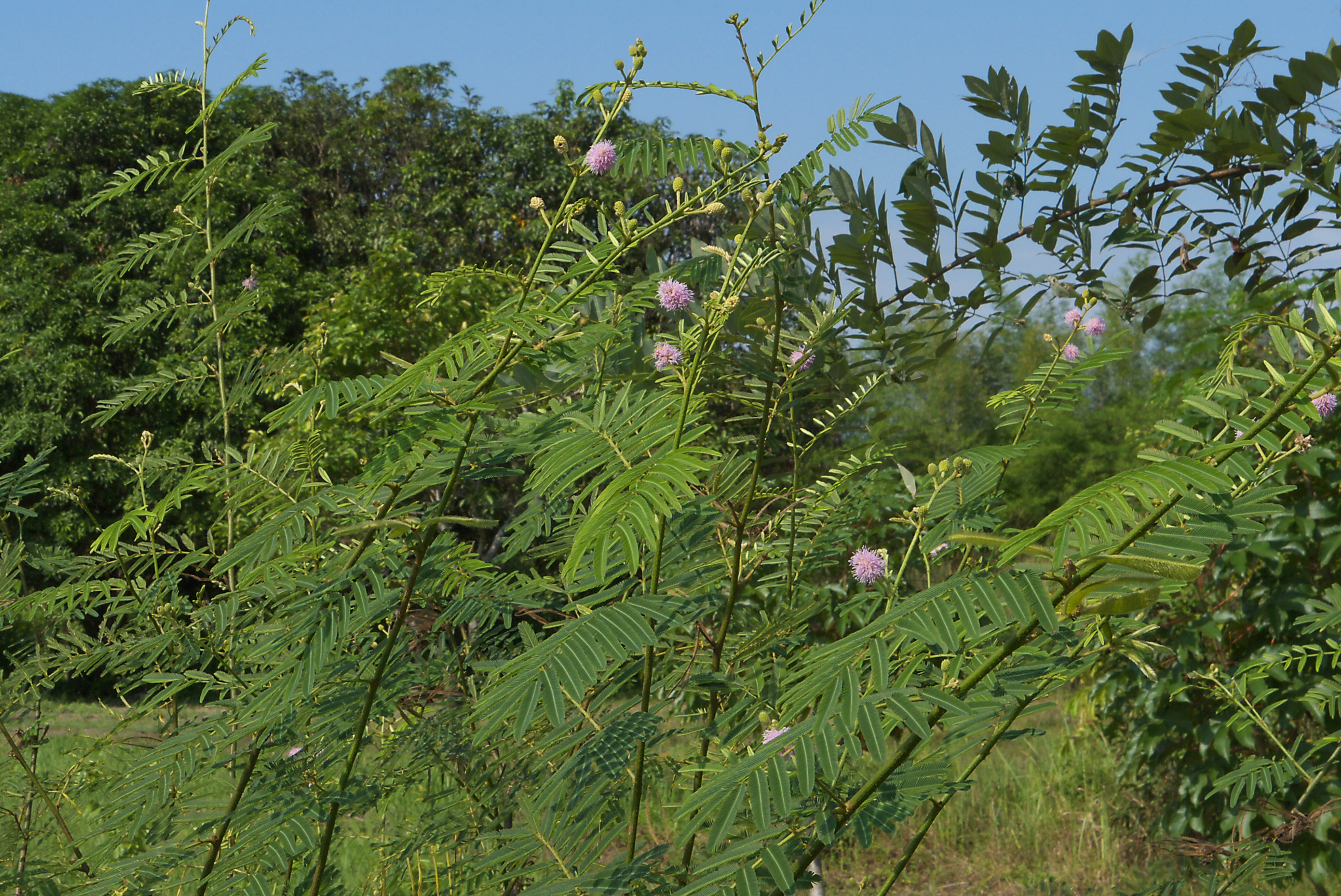 |
| Figure 7: Upright, erect growth of M. pigra (Rodd, 2009) |
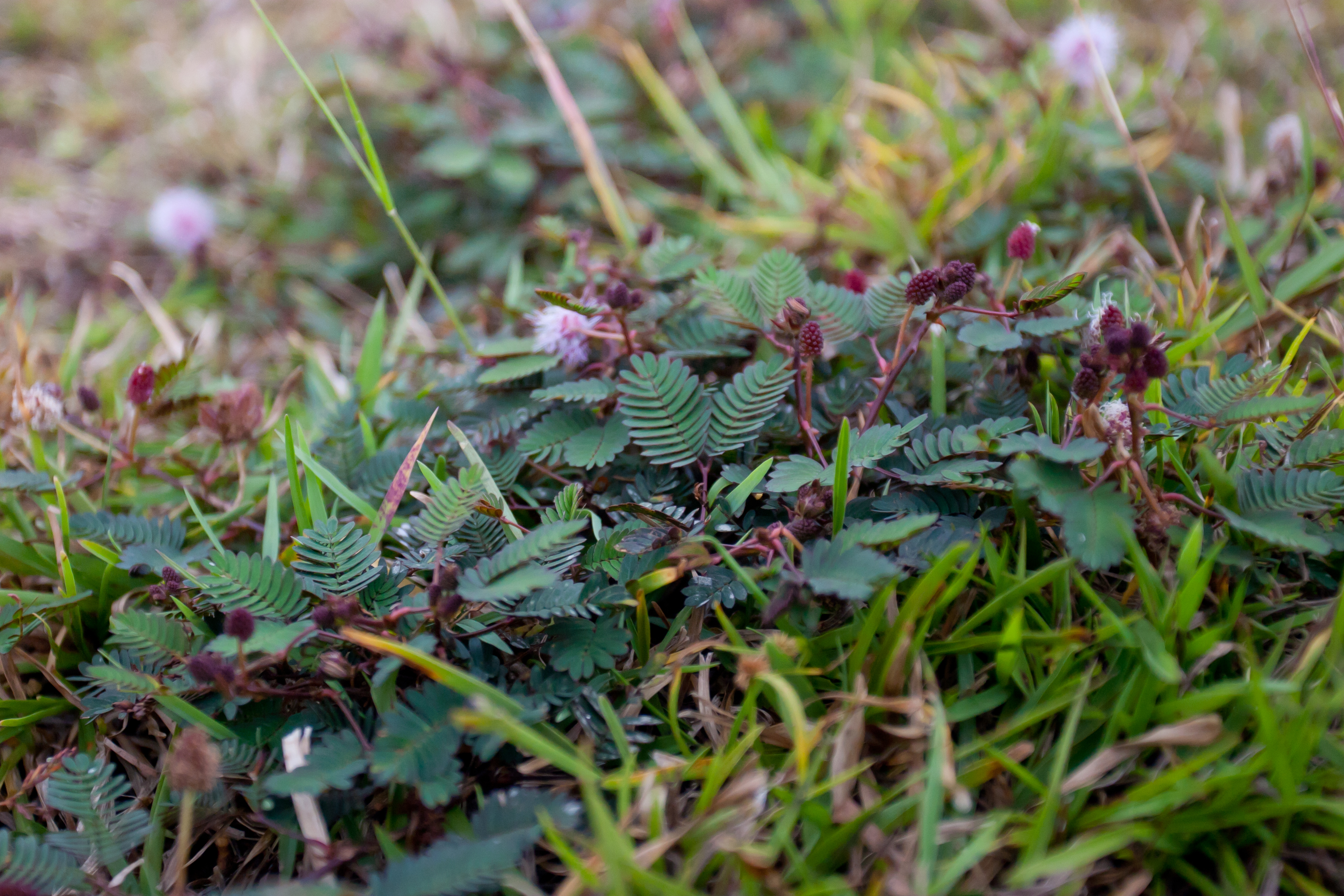 |
| Figure 8: Spreading growth of M. pudica (Hildebrand, 2013) |
Additionally, they differ in the number of branchlets. The M. pudica has only 1-2 pairs of branchlets while the M. pigra and M. diplotricha var. diplotricha each has 6-16 and 4-9 pairs respectively. The largest pods produced by M. pigra can be at least twice the size of the largest pods produced by the other two species [2].
RELEVANCE TO HUMANS
Economic
The extensive growth of the plant can affect plantations adversely because it creates a dense bottom layer that negatively impact the survival of other plants. The plant is considered a serious weed in plantations growing crops ranging from corn to tomatoes to cotton [12].
The interesting behaviour of the plant caught the attention of a company located in the United States of America which launched seeds of the M. pudica in the market. The M. pudica was dubbed as the TickleMe Plant® [13]. The seeds are available for sale internationally and the company’s website contains facts and interactive activities associated with the plant [14].
Ecological
M. pudica is a source of food for some animals, particularly caterpillars. In a study by Williams (n.d.) to investigate the M. pudica in Madagascar, caterpillars were observed to consume highly on the newly grown parts of the plant. The same study also reported on sightings of crickets eating the M. pudica [15].
There are 18,000 species of legumes globally and the M. pudica is one of them [16]. Just like other members of the legume (Fabaceae) family, the M. pudica is capable of fixing atmospheric nitrogen into a form of nitrogen that plants can use directly. This is attributed to the nitrogen fixing bacteria present in its root nodules [17].
Medical
Scientific tests have shown that the M. pudica has huge potential in the medical field. Extracts from the plant have many uses, including acting as a diuretic, promoting nerve regeneration and minimising menorrhagia [12]. Menorrhagia is a condition where women suffer from extremely heavy menstruation [18]. Mimosine, a chemical compound from the plant, has been found to limit the growth of cancerous lung and liver cells too [19]. According to Pham et al. (2008), the drink that their team researched and developed using mimosine extract is beneficial for human health [19]. Nevertheless, consuming large doses of mimosine can be harmful to humans and animals [3].
In addition, there exist many local traditional medical practices involving M. pudica around the world. A study by Lans (2007) found that M. pudica was used to assist in childbirth procedures like the removal of the placenta in Trinidad and Tobago. In Nicaragua and Mexico, the plant has been used to stop menstruation, treat stomach aches and gonorrhoea, a sexually transmitted disease. In India, roots of the plant are used as contraceptives for birth control [20]. In South-east Asia, the plant has been used as a tool to treat insomnia amongst children by laying twigs under their bedding because the leaf-folding behaviour exhibited upon physical disturbance is interpreted as a sleeping behaviour [21].
Conservation
Although the M. pudica population is stable and not under any particular threat globally, its seeds, as shown in Figure 9, have been kept as part of the Millenium Seed Bank Project [22].
 |
| Figure 9: Seeds of M. pudica (Hardyplants, 2008) |
Management
Various measures exist to prevent the spread of the invasive M. pudica [2;12]:
(a) Physical - The presence of thorns and a woody root makes it hard to eradicate the plant via hand weeding as it may result in injuries on the person handling the plant. Fire should not be used as the sole solution because it can encourage further growth and spread of the plant in the long-term. Burning may be suitable when applied with other management methods.
(b) Chemical - Herbicides are useful in controlling the plant. Picloram and triclopyr are two of the most effective herbicides. It is crucial that the plants are not disturbed prior to the application of herbicides because the effect of herbicides is reduced when the leaflets are folded.
(c) Biological - Coir dust (a waste product from coconut processing) and sheep grazing are two biological methods that have been adopted to control the spread of the plant. The former is used in pineapple plantations while the latter is used in pastures.
TAXONOMY
| Figure 10: Lectotype of Mimosa pudica (The Natural History Museum London, n.d.) |
Figure 10 shows a lectotype of the M. pudica deposited at the Natural History Museum, London.
Classification
The classification for M. pudica is as follows [24]:
| Kingdom Plantae |
| Subkingdom Tracheobionta |
| Superdivision Spermatophyta |
| Division Magnoliophyta |
| Class Magnoliopsida |
| Subclass Rosidae |
| Order Fabales |
| Family Fabaceae |
| Genus Mimosa L. |
| Species Mimosa pudica L. |
Synonyms
The synonyms of M. pudica are Mimosa tetrandra Humb. & Bonpl. ex Willd., Mimosa pudica L. var. tetrandra (Willd.) DC., Mimosa unijuga Duch. & Walp., Mimosa pudica L. var. unijuga (Duch. & Walp.) Griseb. [5].
Phylogeny
Readers who are not familiar with phylogeny may refer to the University of California Museum of Paleontology website for an introduction to the topic [25].
To summarise, the study below by Simon et al. (2011) involved the use of different programmes (Nona, BEAST and Mesquite) to derive the evolutionary relationships between the species found under the genus Mimosa. DNA codes and external morphological features of the plants were used in the analysis. The numbers above and below the nodes indicate the strength of the evidence supporting the clade from different analyses. The higher the number, the stronger the evidence. The colours indicate the regions where the plants can be found. The outcome obtained from performing numerous replicates is represented in the phylogenetic tree in Figures 11a and 11b below [26].
For readers who wish to further explore this study, a more detailed and technical version of the study is provided below:
DNA sequences of the trnD-trnT noncoding plastid locus were studied by the researchers and the principle of parsimony was adopted in the construction of this phylogenetic tree. The program Nona was used in this study. 5,000 replicates were performed with 50 trees involved in each replicate. A heuristic search involving tree bisection and reconnection (TBR) as well as branch swapping were performed. Extra searches for trees that are potentially shorter were performed too. Strict consensus bootstrap analyses were done for 1,000 replicates [26].
The program BEAST (ver. 1.4.8) was used to perform the Bayesian analysis to construct the phylogenetic tree and determine the approximate time of divergence. Six characters were chosen in this study - petiolar nectaries, type of inflorescence, number of stamens, number of petals, pollen type and the seismonastic movement of leaves. Data about the first five characters were derived from various published literature while data on the leaf movement was obtained from field work and tests conducted by the team. Mesquite (ver. 2.01) was the program used to construct the 50% majority rule consensus tree where clades that appear at least 50% in all trees are included in the final tree as shown in Figures 11a and 11b [26].
Clades which are well-supported are marked with an alphabet on its node. Colour coding was used to differentiate the geographical distribution of each species. The values above the nodes represent the posterior probabilities while the values below the nodes represent the bootstrap percentages obtained from the parsimony analysis. The asterisk symbol (*) in Figure 11b marks the only clade absent from the parsimonious strict consensus tree [26].
Refer to Simon et al. (2011) for more details about the study.
Note: M. pudica is part of clade P as shown in Figure 11b.
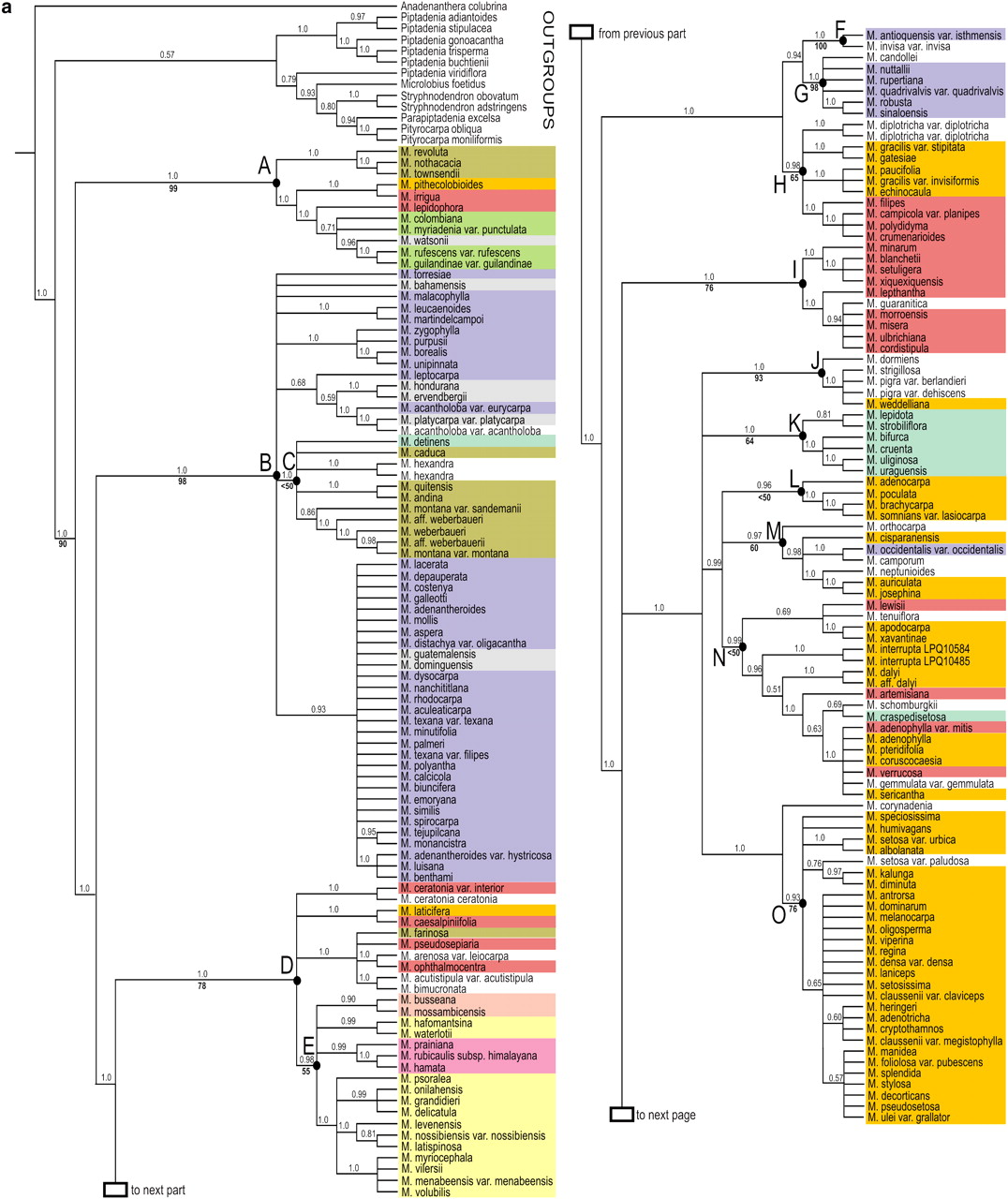 |
| Figure 11a: Phylogeny of genus Mimosa (Simon et al., 2011) |
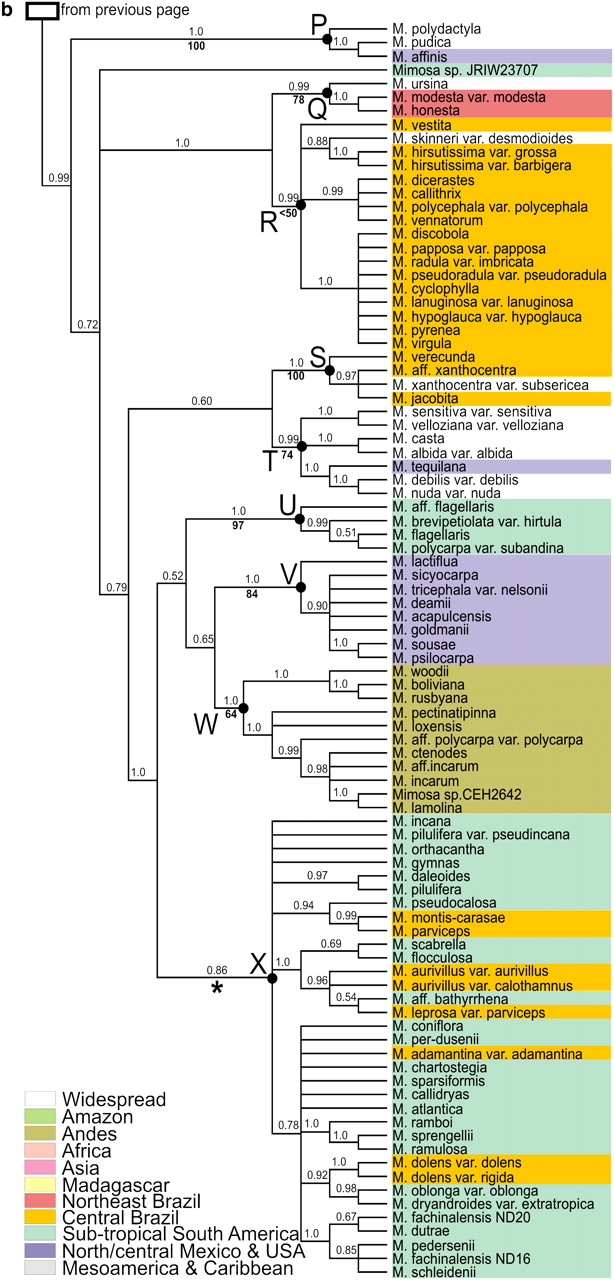 |
| Figure 11b: Phylogeny of genus Mimosa (Simon et al., 2011) |
Evidence supports the monophyletic nature of the genus Mimosa. M. pudica and the other two members in clade P share some similarities such as the extreme sensitivity of the leaves. Further studies are required to determine if there are other species which may belong to clade P [26].
GLOSSARY
| Bipinnate |
Twice pinnate structure; the leaflets are further divided into leaflets [27] |
| Branchlet |
A small branch [28] |
| Capitulum |
An inflorescence with a compact group of sessile flowers on a flattened or vaulted receptacle [29] |
| Clade |
A group consisting of an ancestor and all its descendants [30] |
| Etymology |
The origin and significance of words [30] |
| Inflorescence |
A group of flowers and all their relevant parts [29] |
| Lectotype |
A specimen selected by a later researcher which is designated as if it is the single specimen chosen by the original author (holotype) [32] |
| Legume |
All members of the Fabaceae family which share similar characteristics such as producing fruits that splits equally into two and fixing nitrogen [33] |
| Monophyletic |
A clade where members share a most common recent ancestor [30] |
| Node |
A point on the phylogenetic tree leading to further branching that indicates a split of lineages [30] |
| Nyctinastic |
Leaflets fold during the evening and only unfold during sunrise [10] |
| Parsimony |
Choice is based on the simplest scientific explanation that can explain the outcome; in the tree-building field, the path that requires lesser evolutionary changes is selected [34] |
| Phylogenetic tree |
An illustration of the phylogeny of the taxon studied [30] |
| Phylogeny |
Evolutionary history or development of a taxonomic group of organisms [35] |
| Pulvinus |
A swelling at the base of the leaf stalk, usually associated with or related to glands or respond upon physical contact [29] |
| Seismonastic |
Temporal folding of the leaflets due to external physical disturbance [10] |
| Synonym |
Different scientific names referring to the same organism [36] |
REFERENCES
[1] National Parks Board, Singapore, 2013. Mimosa pudica L. https://florafaunaweb.nparks.gov.sg/Special-Pages/plant-detail.aspx?id=2225# (Accessed 23 Oct 2014).
[2] BioNET-EAFRINET, 2011. Mimosa pudica (Common Sensitive Plant). http://keys.lucidcentral.org/keys/v3/eafrinet/weeds/key/weeds/Media/Html/Mimosa_pudica_(Common_Sensitive_Plant).htm (Accessed 23 Oct 2014).
[3] Davis, S. & Johnson, N., n.d. Mimosa pudica (sensitive plant). http://www.kew.org/science-conservation/plants-fungi/mimosa-pudica-sensitive-plant (Accessed 25 Oct 2014).
[4] Johnston, B., 2009. A Close-up View of the Mimosa. http://www.microscopy-uk.org.uk/mag/artoct09/bj-mimosa.html (Accessed 24 Oct 2014).
[5] Tropical Biology Association, 2006. Mimosa pudica. http://www.tropical-biology.org/research/dip/species/mimosa%20pudica.htm (Accessed 25 Oct 2014).
[6] Sater, J.M., Main, J.A. & McHenry, R., 2012. Plants and Mechanical Motion - A Synthetic Approach to Nastic Materials and Structures. In: N.M. Wereley & J.M. Sater (eds.), Plants and Mechanical Motion - A Synthetic Approach to Nastic Materials and Structure. DEStech Publications, Inc., Lancaster. Pp. 1-32.
[7] Lack, A. & D. Evans, 2005. Instant Notes in Plant Biology. 2nd Edition. BIOS Scientific Publishers Ltd, Oxford, UK. 350pp.
[8] Raven, P., G.B. Johnson, K.A. Mason, J.B. Losos & S.S. Singer, 2010. Responses to Mechanical Stimuli. https://www.inkling.com/read/biology-peter-raven-9th/chapter-41/responses-to-mechanical-stimuli (Accessed 11 Nov 2014).
[9] Volkov, A.G., J.C. Foster, T.A. Ashby, R.K. Walker, J.A. Johnson & V.S. Markin, 2009. Mimosa pudica: Electrical and mechanical stimulation of plant movements. Plant, Cell & Environment, 33(2): 163-173.
[10] Ombrello, T., n.d. The Sensitive Plant. http://faculty.ucc.edu/biology-ombrello/POW/sensitive_plant.htm (Accessed 25 Oct 2014).
[11] Ueda, M., N. Takada & S. Yamamura. Molecular Approach to the Nyctinastic Movement of the Plant Controlled by a Biological Clock. International Journal of Molecular Sciences, 2: 156-164.
[12] IUCN SSC Invasive Species Specialist Group, 2010. Mimosa pudica (herb). http://www.issg.org/database/species/ecology.asp?si=1002&lang=EN (Accessed 25 Oct 2014).
[13] Waheed, 2014. Mimosa pudica: U Can’t Touch This! http://blogs.reading.ac.uk/tropical-biodiversity/2014/02/mimosa-pudica-u-cant-touch-this/ (Accessed 30 Oct 2014).
[14] The TickleMe Plant Company, Inc., 2013. TickleMe Plant®. http://ticklemeplant.com/ (Accessed 30 Oct 2014).
[15] Williams, C. n.d. Mimosa pudica - Sensitive Plant - Is it benefiting the area it is growing in? Frontier BTEC Advanced Diploma Written Report. Adelaide Botanic Garden.
[16] Kricher, J., 2011. Tropical Ecology. Princeton University Press, UK. 704pp.
[17] Ministry of Environment & Forests, Govt. of India, 2011. Mimosa pudica. http://www.kerenvis.nic.in/Database/Mimosapudica_1292.aspx# (Accessed 24 Oct 2014).
[18] Health Promotion Board, 2012. Menorrhagia. http://www.hpb.gov.sg/HOPPortal/article?id=5662 (Accessed 22 Nov 2014).
[19] Pham, N.A.T., T.L. Phan & T.A.D. Dong, 2008. Study on extraction of mimosine from sensitive plant (Mimosa pudica L.) for drinks production. Proceedings:The 1st Conference on Food Science and Technology. Can Tho University, Vietnam. Pp. 104-109.
[20] Lans, C., 2007. Ethnomedicines used in Trinidad and Tobago for reproductive problems. Journal of Ethnobiology and Ethnomedicine, 3(13).
[21] Raffles Museum of Biodiversity Research, 2014. Mimosa pudica. http://lkcnhm.nus.edu.sg/dna/organisms/details/486 (Accessed 27 Oct 2014).
[22] Groom, A., 2012. Mimosa pudica. The IUCN Red List of Threatened Species. Version 2014.2. www.iucnredlist.org (Accessed 27 Oct 2014).
[23] Integrated Botanical Information System, n.d. Mimosa pudica L. http://www.anbg.gov.au/cgi-bin/apni?taxon_id=20037 (Accessed 27 Oct 2014).
[24] United States Department of Agriculture, n.d. Classification. http://plants.usda.gov/java/ClassificationServlet?source=display&classid=MIPU8 (Accessed 29 Oct 2014).
[25] University of California Museum of Paleontology, 2014. Phylogenetics systematics, a.k.a. evolutionary trees. http://evolution.berkeley.edu/evolibrary/article/phylogenetics_01 (Accessed 14 Nov 2014).
[26] Simon, M.F., Grether, R., Queiroz, L.P., Särkinen, T.E., Dutra, V.F. & Hughes, C.E., 2011. The evolutionary history of Mimosa (Leguminosae): Toward a phylogeny of the sensitive plants. American Journal of Botany, 98: 1201-1221.
[27] American Museum of Natural History, n.d. Plant Morphology. http://www.amnh.org/learn/biodiversity_counts/ident_help/Parts_Plants/types_of_compound_leaves.htm (Accessed 12 Nov 2014).
[28] BioNET-EAFRINET,2011. Glossary. http://keys.lucidcentral.org/keys/v3/eafrinet/weeds/key/weeds/Media/Html/glossary.htm (Accessed 22 Nov 2014).
[29] Flora Nordica, n.d. Morphological terms. http://www.floranordica.org/info/termlistfiler/eng-eng.html (Accessed 12 Nov 2014).
[30] Keesey, T.M. & P. Cantino. Glossary. http://www.ohio.edu/phylocode/glossary.html#glossary-c (Accessed 13 Nov 2014).
[31] Biology Online, 2005. Etymology. http://www.biology-online.org/dictionary/Etymology (Accessed 12 Nov 2014).
[32] The New York Botanical Garden, 2003. Type Definition. http://sciweb.nybg.org/science2/herbarium_imaging/typedefinition.asp.html (Accessed 21 Nov 2014).
[33] Seigler, D.S. 2005. Legumes. http://www.life.illinois.edu/ib/363/LEGUMES.html. (Accessed 22 Nov 2014).
[34] University of California Museum of Paleontology, 2014. Reconstructing trees: Parsimony. http://evolution.berkeley.edu/evolibrary/article/phylogenetics_08 (Accessed 13 Nov 2014).
[35] Biology Online, 2009. Phylogeny. http://www.biology-online.org/dictionary/Phylogeny (Accessed 13 Nov 2014).
[36] ScaleNet, 2014. Glossary. http://www.sel.barc.usda.gov/scalenet/glossary.htm. (Accessed 12 Nov 2014).
Permission status for figure reproduction
[Figure 1] Hrushikesh, 2011. File:Mimosa pudica.gif. http://commons.wikimedia.org/wiki/File:Mimosa_Pudica.gif (Accessed 29 Oct 2014).
[Figure 2] Armstrong, E.M., 2002. Leaf Terminology Part I. http://waynesword.palomar.edu/termlf1.htm (Accessed 29 Oct 2014).
[Figures 3-6] Johnston, B., 2009. A Close-up View of the Mimosa. http://www.microscopy-uk.org.uk/mag/artoct09/bj-mimosa.html (Accessed 24 Oct 2014).
[Figure 7] Rodd, T., 2009. Mimosa pigra 091029-0204.
https://www.flickr.com/photos/tony_rodd/4475470047/in/photolist-cB98kb-cB96Yq-exPbS5-exL1t6-exPbnJ-exL1kP-exPb8u-oJMYrZ-p22nJF-p2hM8t-oZfVQq-p2fW71-4gmVBi-4gmVtB-a5Hmng-a5Ld7N-a5LcZf-a5HmbR-a5HkQK-4gqZqW-7PxWcd-a5Ldtw-9Vx4dc-9Vx5oX-exPc6j-oJMXDg-p2hLVV-4gqZ59-p2fVAG-p2hLFB-p2hLyH-afF2mx-nSSHFx-7PtXyH-4gqZp1-7PxWjs-7PtXjF-7PxWz3-at8Abk-at8Crc-atbfg5-at8CMz-j3gEL6-ofGBBq-ofAnWi-ohDFFR-8YmgQ1-8Ymh5A-4bkM9t-9Vx3cB (Accessed 21 Nov 2014).
[Figure 8] Hildebrand, E., 2013. Mimosa pudica. https://www.flickr.com/photos/emilyrachelhildebrand/9565668204/ (Accessed 21 Nov 2014).
[Figure 9] Hardyplants, 2008. File: Seeds Mimosa pudica.jpg. http://commons.wikimedia.org/wiki/File:SeedsMimosa_pudica.jpg (Accessed 12 Nov 2014).
[Figure 10] The Natural History Museum, London, n.d. The George Clifford Herbarium.
http://www.nhm.ac.uk/research-curation/scientific-resources/collections/botanical-collections/clifford-herbarium/database/detail.dsml?B=BM000628752&&beginIndex=1588&listPageURL=list.dsml%3FbeginIndex%3D1560 (Accessed 21 Nov 2014).
[Figures 11a & 11b] Simon, M.F., Grether, R., Queiroz, L.P., Särkinen, T.E., Dutra, V.F. & Hughes, C.E., 2011. The evolutionary history of Mimosa (Leguminosae): Toward a phylogeny of the sensitive plants. American Journal of Botany, 98: 1201-1221.
| Figure 1 |
File by Hrushikesh is made available under the Creative Commons CC0 1.0 Universal Public Domain Dedication. |
| Figure 2 |
Pending permission. Permission requested from Wayne’s Word on 29 Oct 2014 |
| Figures 3 - 6 |
Photo permission granted by Brian Johnston on 24 Oct 2014 |
| Figure 7 |
File by Rodd is made available under the Creative Commons license |
| Figure 8 |
File by Hildebrand is made available under the Creative Commons license |
| Figure 9 |
File by Hardyplants is made available into the public domain |
| Figure 10 |
Pending permission. Permission requested from The Natural History Museum, London on 21 Nov 2014 |
| Figures 11a & 11b |
Pending permission. Permission requested from American Journal of Botany on 03 Nov 2014 |